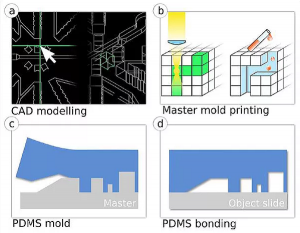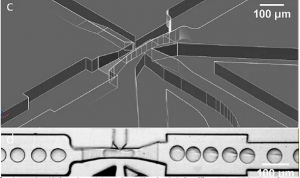 Swiss high-tech company FEMTOprint, dedicated to contract manufacturing of 3D printed microdevices in glass and other transparent materials, worked with Galatea Lab, Instant Lab and the Jules-Gonin Ophthalmic Hospital this past winter to explore how 3D printing could be used to further innovate the med-tech industry. Now, the company is lending its talents to the production of 3D printed glass molds for droplet microfluidic chips. Its technology can grow the experimental capabilities of droplet microfluidic chips
Swiss high-tech company FEMTOprint, dedicated to contract manufacturing of 3D printed microdevices in glass and other transparent materials, worked with Galatea Lab, Instant Lab and the Jules-Gonin Ophthalmic Hospital this past winter to explore how 3D printing could be used to further innovate the med-tech industry. Now, the company is lending its talents to the production of 3D printed glass molds for droplet microfluidic chips. Its technology can grow the experimental capabilities of droplet microfluidic chips
The research, detailed in a recent case study, was carried out alongside researchers from the Leibniz Institute for Natural Product Research and Infection Biology (Leibniz HKI) in Germany.
“We have been working together with FEMTOprint for more than 2 years now, as we see in their technology potential to expand the possibilities of our microfluidic structure designs,” said Miguel Tovar with the Leibniz HKI and Hans Knöll Institute. “They offer the best methodology for the fabrication of 3D structures with micrometric resolution without requiring unsurmountable pay or time walls. Contrarily, they have become an additional team member. We look forward to further collaborations.”

Production of a PDMS chip from 3D glass molds. (a) Construction of 3D CAD model. (b) Fabrication of glass master mold with femtosecond laser machining. (c) Soft-lithographic production of a PDMS mold (blue) from the glass master mold. (d) Plasma bonding of PDMS stamp to an object slide.
The collaborative research team – made up of scientists from Leibniz HKI, Friedrich Schiller University, the Ilmenau University of Technology, FEMTOprint, and the Fraunhofer Institute for Applied Optics and Precision Engineering (Fraunhofer IOF) – fabricated 3D PDMS (silicone rubber) chips for droplet microfluidics by using FEMTOprint’s innovative glass technology to make 3D printed glass molds. FEMTOprint’s direct writing process makes it possible to create microfluidic designs with different levels, continuously changing heights, and complex 3D shapes, along with sub-micrometric resolution.
This new technique, when paired with simple PDMS replica molding, can provide users with a solution for non-specialized and specialized labs in order to customize and expand microfluidic experimentation.
The researchers published a paper, titled “3D-glass molds for facile production of complex droplet microfluidic chips,” in the Biofabrication journal; authors are Miguel Tovar, Thomas Weber, Sundar Hengoju, Andrea Lovera, Anne-Sophie Munser, Oksana Shvydkiv, and Martin Roth.
The abstract reads, “In order to leverage the immense potential of droplet microfluidics, it is necessary to simplify the process of chip design and fabrication. While polydimethylsiloxane (PDMS) replica molding has greatly revolutionized the chip-production process, its dependence on 2D-limited photolithography has restricted the design possibilities, as well as further dissemination of microfluidics to non-specialized labs. To break free from these restrictions while keeping fabrication straighforward, we introduce an approach to produce complex multi-height (3D) droplet microfluidic glass molds and subsequent chip production by PDMS replica molding.”

Droplet trapping chip for prolonged observation and imaging, including differently shaped chambers of variable depth.
This new technique allows for novel new possibilities in the industry, which can be exploited with microfluidics applications and droplets. As of right now, no other simple methodology but this one exists that would allow architectures with structures from 15 µm to hundreds of micrometres in all dimensions to be produced.

Design approaches with ramps to observe droplet contents in flow under different channel heights shown as sketch as well as to improve picoinjection.
3D printed glass molds can be used to combine the replication and ease of production that soft lithography is capable of with the advantages of high-resolution prototyping. Additionally, it can facilitate fabrication of multilevel structures – even ones with gradients of confinement, which can make important droplet microfluidic operations better.
According to FEMTOprint, 3D printed glass structures “represent a negative part,” and they can also be directly used as chips by bonding them to a PDMS slab or glass; this makes it possible to utilize structures, like mirrors, lenses, and filters, that replica molding cannot recreate.
The 3D printed glass mold can pack 192 nozzles into a design that’s 25 mm long and 4 mm wide, including all inlets and outlets, which will generate monodisperse droplets of ø70 µm. It’s also easy to scale this structure so it is capable of holding 1,000 nozzles in a 6.5 cm structure. Now, thanks to possibilities opened up by this research, chip fabrication doesn’t have to be the bottleneck for non-microfluidic labs adopting microfluidic approaches. Instead, it should be looked at as a way to implement novel functionalities, like optical fiber integration for fluorescence detection.
Discuss this story and other 3D printing topics at 3DPrintBoard.com or share your thoughts in the Facebook comments below.
[Images: Miguel Tovar, Leibniz Institute]Subscribe to Our Email Newsletter
Stay up-to-date on all the latest news from the 3D printing industry and receive information and offers from third party vendors.
You May Also Like
High Stakes, High Speed: KVG Acquires 15 Nexa3D HSE 3D Printers to Boost Military Tech
As 3D printing increasingly intersects with defense and military logistics, a new partnership between Nexa3D and mission support logistics firm KVG stresses the growing importance of this technology in strategic...
3D Printing Webinar and Event Roundup: April 28, 2024
In this week’s 3D Printing Webinar and Event Roundup, the Ceramics Expo is taking place in Michigan, Stratasys continues its advanced training courses, and SPE is holding a Polymer Characterization...
Attending the ASTM F42/ISO TC 261 Meetings: The Nitty-Gritty of Additive Manufacturing
I never thought I’d be so excited about an event focused on additive manufacturing (AM) standards, but here we are! When I learned that the recent biannual ASTM F42/ISO TC...
World’s Largest Polymer 3D Printer Unveiled by UMaine: Houses, Tools, Boats to Come
The University of Maine has once again broken its own record by unveiling the largest polymer 3D printer in the world. Surpassing its 2019 achievement, the new Factory of the...































